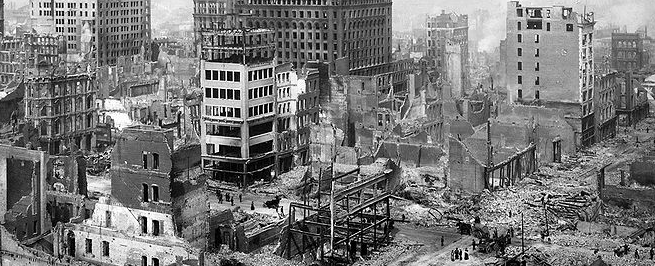Shock Waves – 100 years after the great San Francisco earthquake

Alongside the Galveston Hurricane of 1900 and Hurricane Katrina in 2005 the earthquake that struck San Francisco and the coast of Northern California in the early hours of April 18, 1906 is still one of the biggest natural disasters in United States history. The initial shock happened at 05:12 am and was followed by 60 second main shock around 25 seconds later.
The most widely accepted estimate for the magnitude of the earthquake is a moment magnitude (Mw) of 7.9, however, other values have been proposed, from 7.7 to as high as 8.25. The main shock epicenter occurred offshore about 3.2 km (2 miles) from the city, near Mussel Rock. Shaking was felt from Oregon to Los Angeles, and inland as far as central Nevada.
The earthquake damaged buildings and structures in all parts of the city and county of San Francisco, although over much of the area, the damage was moderate in amount and character.
Ruptured gas pipes and up-turned ovens led to an even deadlier danger as thousands of individual fires were ignited. These individual fires quickly joined together to engulf the city.

San Francisco fire 1906 – Panoramic photographs, Library of Congress, Reproduction Number: LC-USZ62-130410
The number of casualties is still uncertain today, and is estimated to be roughly 3 000 at minimum. Between 227 000 and 300 000 people were left homeless out of a population of about 410 000. Half of the people who evacuated fled across the bay to Oakland and Berkeley. Newspapers at the time described Golden Gate Park, the Presidio, the Panhandle and the beaches between Ingleside and North Beach as being covered with makeshift tents. More than two years later, many of these refugee camps were still in full operation.
This earthquake caused the most lengthly rupture of a fault that has been observed in the contiguous United States. The displacement of the San Andreas Fault was observed over a distance of 300 kilometers from San Juan Bautista to Point Arena, where is passes out to sea. Additional displacement was observed farther north at Shelter Cove in Humbolt County, and, assuming the rupture was continuous, the total length of rupture would extend 430 kilometers. The largest horizontal displacement – 6.4 meters – occurred near Point Reyes Station in Marin County.
In the public's mind, this earthquake is perhaps remembered most for the fire it spawned in San Francisco, giving it the somewhat misleading appellation of the "San Francisco earthquake". Shaking damage, however, was equally severe in many other places along the fault rupture.
The video presented below, "Shock Waves" is an Emmy Award nominated USGS television program that aired on San Francisco's CBS-5 in April, 2006 during the week of the 100 year anniversary of the Great San Francisco Earthquake. The program is hosted by Dana King and was produced and directed by Stephen M. Wessells.
It traces the century of scientific and engineering progress since the great quake. Historical recreations, hundred-year-old film footage, and stunning still photographs convey the extent of the destruction and the human and scientific response to the catastrophe. The program features 3D animations, cutting edge research and expert interviews with some of the world's premiere seismologists and engineers. The Bay area is presented as a showcase for earthquake preparedness.

Video courtesy: USGS
Copyright note: Engineering animations are owned by SEONC and Forell/Elsesser Engineers and U.C San Diego. Japanese quake video from convenience store security cameras and TV studio security cameras is owned by NHK, Japan. Classroom earthquake happening shot is owned by the University of California. 1989 Loma Prieta Earthquake video shots are owned by KPIX CBS-5, San Francisco. Any use of these materials requires written permission from the respective owners of this material listed here.
Featured image: San Francisco Earthquake of 1906: Ruins in vicinity of Post and Grant Avenue. Photographer: Chadwick, H. D

Commenting rules and guidelines
We value the thoughts and opinions of our readers and welcome healthy discussions on our website. In order to maintain a respectful and positive community, we ask that all commenters follow these rules.